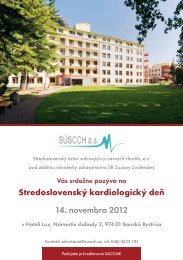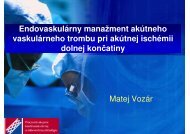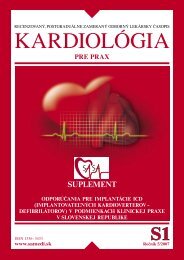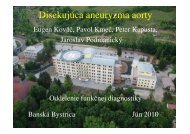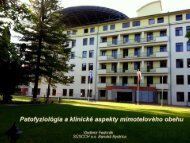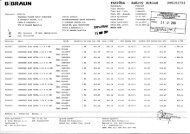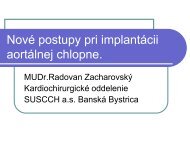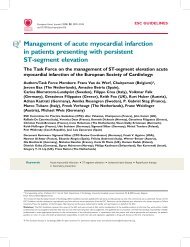Endovaskulárne techniky rekanalizácie femoropliteálnych okluzií
Endovaskulárne techniky rekanalizácie femoropliteálnych okluzií
Endovaskulárne techniky rekanalizácie femoropliteálnych okluzií
Create successful ePaper yourself
Turn your PDF publications into a flip-book with our unique Google optimized e-Paper software.
Rekanalizácia dlhých<br />
femoropopliteálnych oklúzií<br />
Zdeněk Opravil, Matej Vozár
TASC II
Techniky<br />
• intraluminálna rekanalizácia – nízka<br />
technická úspešnosť<br />
• PIER (percutaneous intentional<br />
extraluminal recanalisation) – Bolia<br />
1990, Reekers 1998 – metóda SIR<br />
Bolia et al. PTA of occlusions of the femoral and popliteal arteries by subintimal<br />
dissections. CVIR 1990; 13: 357-363<br />
Reekers JA, Bolia A. Percutaneous intentional extraluminal (subintimal) recanalisation:<br />
how to do it yourself. EJR 1998; 8: 192-198
Re-entry
Výsledky na SÚSCCH a.s.<br />
• 05/2009 – 05/2011: 59 pacientov s<br />
chronickou oklúziou fem-pop. riečiska<br />
> 10cm (63 oklúzií/končatín)<br />
• TASC II B-D; Fontain IIb-IV<br />
• intraluminálna rek. 15,9% x SIR 84,1%<br />
• 16x reentry katéter,1xTE<br />
• nitinolové SE stenty v 100%<br />
• primárna technická úspešnosť 90,5%<br />
• 8 reangiografií u 7 pacientov: 1xDSA,<br />
3xS/PTA pre restenózu, 3xTE, 1x neúsp.<br />
rekanalizácia FP bypass
Kazuistika I<br />
• 72r. muž, DM II na inzulíne, ICHS, st.p.<br />
NSTEMI, st.p.impl. PM, AHT, HLP, st.p.<br />
operácii moč. mechúra pre ca<br />
• PAO DK bilat., st.p. femoropopliteálnom<br />
bypasse vľavo s včasnou oklúziou, posl. 2<br />
mesiace kľudové ischemické bolesti (CLI)<br />
• LABI 0,41
Kazuistika II<br />
• 58r. muž, DM II na inzulíne s org.<br />
komplikáciami (nefropatia, makroangiopatia),<br />
ICHS s EF 35%, AHT, HLP, st.p. RAS sin<br />
• PAO DK, st.p. FP bypasse vpravo, st.p.<br />
amputácii P predkolenia pre diabetickú<br />
gangrénu<br />
• vľavo intermitentné lýtkové klaudikácie do<br />
20m a v poslednej dobe kľudové ischemické<br />
bolesti
Komplikácie<br />
• 64r. pacient 3t. po rekanalizácii CTO AFS<br />
sin, 2t. po PVI relaps krátkych klaudikácií v<br />
ľavom lýtku a počínajúce pokojové bolesti,<br />
ĽDK chladná, ABI nemerateľné<br />
• CDUS suponovaná in-stent reoklúzia
Komplikácie<br />
• 73r. žena prijatá 3t. po PVI na panvovom a<br />
FP riečisku vľavo (rekanalizácia CTO)<br />
• 3 dni po PVI vynechaná duálna<br />
antiagregácia pred stomatologickým<br />
zákrokom a podávaný LMWH 0,3ml<br />
1xdenne, 3.deň po vysadení ANP a<br />
clopidogrelu obraz ALI, konzervatívny<br />
postup zlyhal<br />
• pri prijatí ľavé predkolenie chladné, livídne,<br />
s akrálnou poruchou citlivosti aj motoriky
po 24h lokálnej TL
EBM: SIR vs BG<br />
Bypass: zlatý štandard ale…<br />
Morbidita<br />
•Zlyhanie graftu 0-24%<br />
•Infekcia rany 10-20%<br />
•Chirurgická revízia >20%<br />
•Infekcia graftu<br />
•Komplikácie v mieste odberu žily<br />
•Opuch končatiny – min. 2-3 mesiace po BG<br />
•Peri-operačné komplikácie ako IM, pneumónia, HVT<br />
Operačná mortalita 1.3-6%<br />
TASC Consensus; J Vasc Surg, Jan 2000, Part 2, Vol. 31 2. Ann Vasc Surg. 2003 Mar;17(2):198-<br />
202. Epub 2003 Mar 6. Complication registration in patients after peripheral arterial bypass<br />
surgery. Schepers A, Klinkert P, Vrancken Peeters MP, Breslau PJ
EBM: SIR vs BG<br />
• 1076 pacientov s PAO DK<br />
2002 – 2007<br />
• 206 SIR u 190 pacientov<br />
• 128 BG u 119 pacientov<br />
• Cost-per-QALY<br />
(quality-adjusted life year):<br />
SIR €5663 vs BG €9172<br />
Clinical<br />
Improvement<br />
Five-year all<br />
cause survival<br />
Amputationfree<br />
survival<br />
Five-year<br />
freedom from<br />
binary<br />
restenosis<br />
Five-year<br />
freedom from<br />
TLR<br />
SIR BG p<br />
82.8% 68.2% p=0.106<br />
78.6% 80.1% p=0.734<br />
72.9% 71.2% p=0.976<br />
72.8% 65.3% p=0.700<br />
85.9% 72.1% p=0.262<br />
Five-Year Irish Trial of CLI Patients With TASC II Type C/D Lesions Undergoing Subintimal<br />
Angioplasty or Bypass Surgery Based on Plaque EcholucencySherif Sultan et all, J Endovasc<br />
Ther. June 2009, Vol. 16, No.3, pp. 270-283
EBM: SIR vs BG<br />
Subintimal Angioplasty as a Primary Modality in the Management of<br />
Critical Limb Ischemia: Comparison to Bypass Grafting for Aortoiliac and<br />
Femoropopliteal Occlusive Disease<br />
Niamh Hynes, et all, J Endovasc Ther. 2004 Aug;11(4):460-71
Subintimal angioplasty for advanced lower extremity ischemia due to<br />
TASC II C and D lesions of the superficial femoral artery. Sidhu R et al.<br />
Vasc Endovascular Surg. 2010 Nov;44(8):633-7. Epub 2010 Jul 30<br />
OBJECTIVE:<br />
Subintimal angioplasty (SA) has evolved into a viable<br />
revascularization procedure for complex lower extremity lesions. Although<br />
patency rates are lower than those for autogenous bypass, limb salvage rates<br />
are comparable. This study reviewed the 8-year experience of SA in a single<br />
center.<br />
METHODS:<br />
Records of patients undergoing SA were reviewed. Clinical presentation and<br />
noninvasive exams were used to classify patients. Lesions were categorized by<br />
TransAtlantic InterSociety Consensus (TASC) II guidelines. Outcomes included<br />
technical success, patency, amputation-free survival, and limb salvage.<br />
RESULTS:<br />
120 patients with TASC II C/D lesions underwent SA. Technical success was<br />
91%. Primary patency at 6 and 12 months was 90% and 73%. Secondary<br />
patency at 6 and 12 months was 94% and 85%. One-year amputation-free<br />
survival was 90%. One-year limb salvage was 98%.<br />
CONCLUSIONS:<br />
SA for TASC C/D lesions is a safe procedure and may be considered an<br />
alternative to bypass, especially in high-risk patients.
Clinical follow-up in endovascular treatment for TASC C-D lesions in femoro-popliteal<br />
segment. Rabellino M et al. Catheter Cardiovasc Interv 2009; 5: 701 - 705<br />
Objective:<br />
To demonstrate the technical success and clinical follow-up after endovascular treatment of femoropopliteal<br />
segment TASC II C and D lesions.<br />
Methods:<br />
From July 2002 to February 2007, 234 limbs in 190 patients with femoropopliteal segment TASC II C (n = 112)<br />
and D (n = 122) lesions were treated. Endovascular treatment consisted of PTA, fibrinolysis and PTA,<br />
subintimal recanalization and PTA, and finally stent graft. Patients were clinically evaluated at 30 days, 3, 6<br />
month, and at 1 year in the outpatient setting with clinical examination and ankle-brachial indices (ABI). In the<br />
case of stent placement, additional ultrasound evaluation was performed at 12, 24, and 48<br />
month.<br />
Results:<br />
49.5% of procedures were performed on patients with lifestyle-limiting claudication (IC) and 50.5% were<br />
performed for critical limb ischemia (CLI). Technical success, defined as successful recanalization and<br />
treatment of the occluded vessel, was achieved in 97% of cases. Periprocedural mortality was 3.15% and<br />
all deaths occurred in the CLI group. A follow-up 13 ± 6 months and was achieved in 76%. During the<br />
follow-up, clinical outcome for IC group and clinical CLI group was asymptomatic 72% vs. 29.8%,<br />
symptomatic with clinical improvement 22% vs. 33.7%, and major amputation 3% vs. 23.3%.<br />
Conclusion:<br />
The majority of claudicating patients with femoropopliteal TASC II C and D lesions will benefit from the<br />
endovascular treatment. Patient presenting CLI have a worse outcome, nevertheless the endovascular<br />
treatment can delay amputation, preserving the native vessel and does not impede surgical bypass if needed.<br />
For this reason, we consider that endovascular treatment may be the first choice treatment even in<br />
femoropopliteal TASC II C and D lesions. © 2009 Wiley-Liss, Inc.
EBM – nitinolové stenty<br />
1. Mewissen MW Tech Vasc Interv Radiol 2004; 7:2-5.<br />
2. Vogel TR et all. J. Vasc Surg 2003; 38:1178-84.<br />
3. Ansel et Al. Catheter Cardiovasc Interv 2006; Jan 11.<br />
4. Duda SH et all SIROCCO II. J Vasc Interv Radiol 2005; 16: 331-38.<br />
5. Biamino G et all FESTO Trial. TCT 2004C
Záver<br />
• EVL je vo fem-pop riečisku<br />
plnohodnotnou alternatívou<br />
chirurgických rekonštrukcií aj u dlhých<br />
oklúzií (TASC II C-D)<br />
• u chirurgicky rizikových pacientov<br />
metóda voľby



